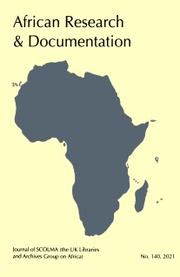No CrossRef data available.
Article contents
Libraries in Northern Nigeria Issues and Prospects
Published online by Cambridge University Press: 25 April 2022
Extract
Nigeria, independent since 1960, is today a country with a population of over 120 million, of whom only about 30% are literate. Serving that population are 25 universities, 35 polytechnics and 60 colleges of education. The North, twothirds of the landmass of the country, holds slightly over 60% of the total population of the country.
The Ministry of Education, through the Nigeria Universities Commission, stipulated in the late 1990s that 10% of capital cost should go as library funding to Nigerian universities. There has been a significant increase in the funding of colleges of education with the establishment of the National Commission for Colleges of Education, while the National Board for Technical Education regulates the activities of Polytechnics. All these new developments have come into being since the late 1970s.
- Type
- Articles
- Information
- Copyright
- Copyright © International African Institute 2002


